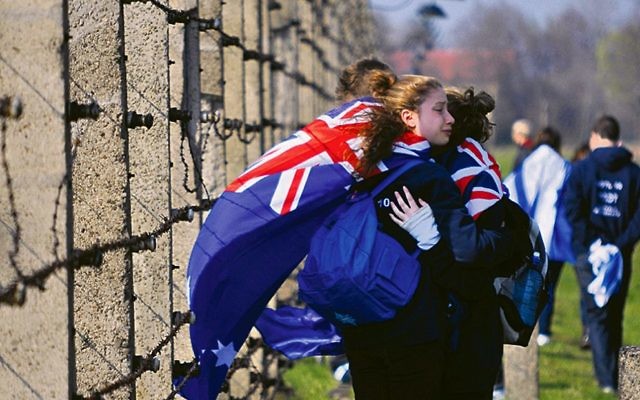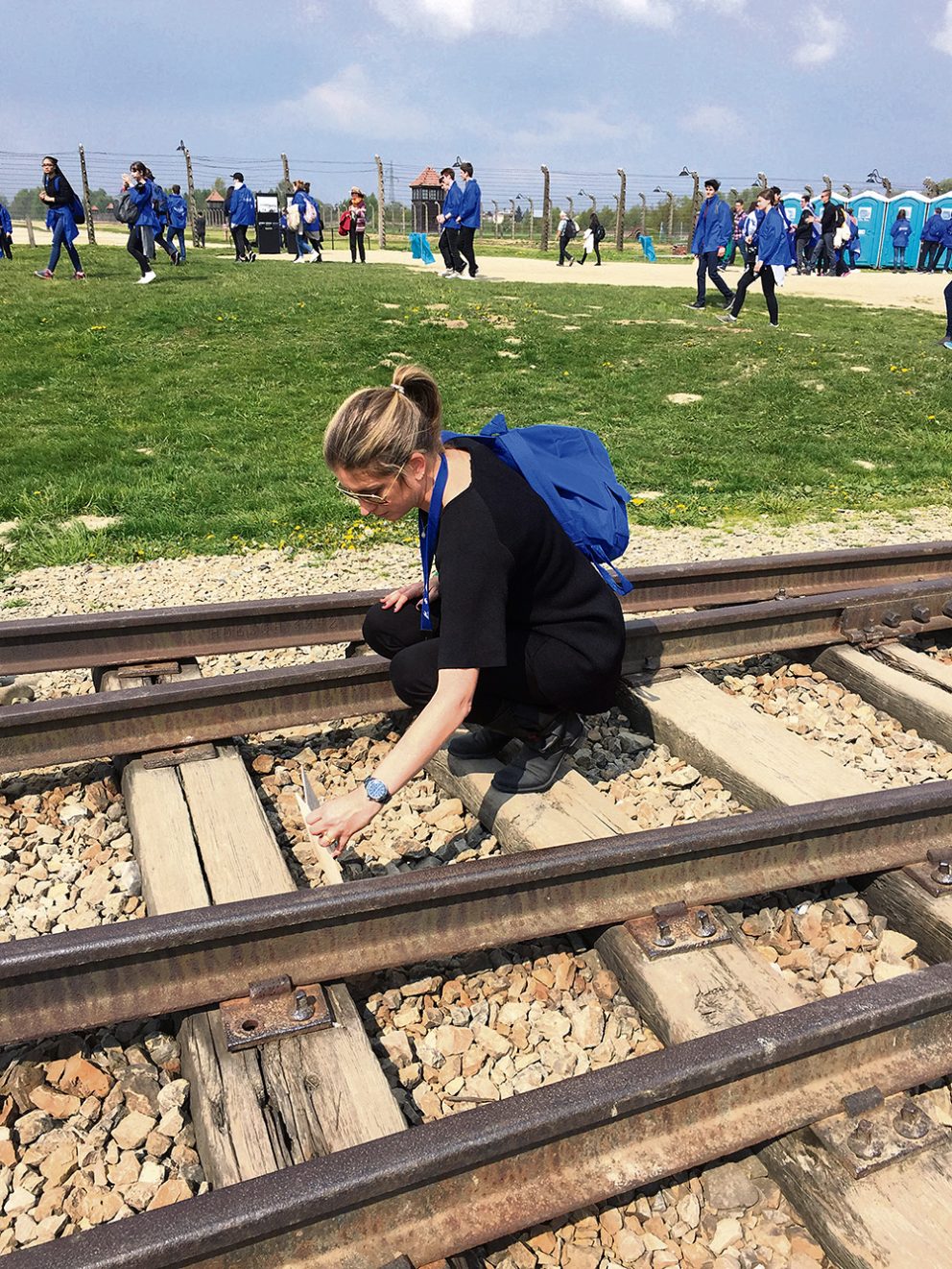‘We are still here’
This Yom Hashoah marks the 30th anniversary of March of the Living. Participants from over the years share their very personal highs and lows with Rebecca Davis.
Piles of shoes. It is a distinct memory that stands out for Ben de Winter when reflecting on his visit to Majdanek Concentration Camp on March of the Living (MOTL).
He was 16 and it was snowing when he visited, the persistent Polish winter stretching into spring. And there in the darkness of memory and misery and a sea of leather, lay one small, pink shoe.
“At that moment, I felt such a strong connection to my family, and to my Judaism,” tells Ben, now aged 21.
“All of a sudden, I understood the significance of being a young Jew in Poland, and the importance of carrying on that memory, ‘Never again’.”
They are the two words that 67 Australians hold with them as they participate in MOTL this year. The program is now currently under way in its 30th year worldwide and 17th year in Australia. It begins with a week long journey in Poland where participants visit former centres of Jewish life and culture before venturing to sites of Nazi persecution. On Yom Hashoah, more than 15,000 MOTL participants from all over the world converge on Auschwitz. Together, they march the three kilometres to Birkenau, a contrast with the death marches which were inflicted upon approximately 750,000 prisoners. From the lows of the attempted destruction of the Jewish people, participants then travel to Israel to celebrate Yom Ha’atzmaut and experience the highs of the birth of the Jewish nation that rose from the ashes of Europe.
Saul Muscatel’s grandmother, now 93, survived Auschwitz.
As the afternoon sun peeks through the shutters and streams across their family’s sitting room, she is proudly poised in her armchair as she listens to her grandson speak. A mother of three, and grandmother of seven, she is a matriarch with a commanding yet warm presence. “Haymishe” and “with heart” to use words that she might choose, words that punctuate with a thick Yiddish accent.
Saul was just 17 when he decided to participate on MOTL. Alone, without a friend or family member, he embarked upon the journey.
“I was still discovering the many aspects of the Holocaust and what happened,” reflects Saul, now 27.
“I didn’t really know much about it other than my grandparents went through it. But it wasn’t real for me. It was sort of just like a story that was passed down and I didn’t really get a sense of what it was.”
Then he remembers the impact of seeing the first camps.
“I could actually feel the rocks beneath my feet, and touch the barbed wire. And it was just another feeling, another level.”
At Treblinka, the grim reality and gross enormity of the loss set in. Passing barrack after barrack, there was one in particular that stays with him.
“I walked in … and there was just one cage in the middle, and the entire cage was filled to the ceiling with just shoes.
“And I’m walking down this barrack. And I’m walking, and I’m walking, and I’m walking, and the walk was just so long, and I’m becoming so emotional and that’s – that’s when it became really real for me,” he pauses, eyes wide and distant, reliving the moment.
“That’s when it was just a massive hit to me: this is mankind’s greatest atrocity. How could this happen? Why? It seems impossible, and yet it happened. It’s just … unfathomable … beyond comprehension.
“It was the meeting of the middle ground, between reality and disbelief.”
Saul immediately left the barracks, and waited back at the bus for the group.
But the experience of visiting the camps wasn’t entirely clouded in negativity. The most uplifting encounter was to be found in the most surprising of places – Auschwitz.
Surrounded by thousands, Saul was about to commence the march. While his thoughts were with his Nanna and family whom he was missing terribly, he suddenly heard his name and felt a tap on the shoulder.
“I turned around, and it was a second cousin from Los Angeles. He was just there! He recognised me from a photo. We’d never even met before and it’s amazing to think the first time was in Auschwitz!
“It was Nanna’s side of the family coming back together, reuniting in the place considered hell on earth, almost like bashert or fate.”
In the ultimate act of defiance, there, set against the backdrop of the brick-paved vehicle that had facilitated the mass destruction of families and histories and futures, at the scene where the lives of millions of Jews had been stolen, family members were reunited, self-determination reclaimed.
“The Jewish people have been persecuted for thousands of years and it really did show, we are here. We are still here,” Saul adds thoughtfully.
Two years ago, 43-year-old mother-of-two Dana Burrows went on the March with her mother and cousin, remembering it to be “incredibly emotional”.
“Never have I felt such loss and triumph together. The day before the walk we said kaddish for my great-grandmother and great-uncle at the stairs of the crematorium where they perished.”
During the March, Dana walked alongside survivors, some in their striped prison uniforms.
“Their strength was incredible. I looked around and the spirit that was stolen from us at that very place had returned in abundance,” says Dana.
It was a feeling shared by Sarah Reid, a participant in the inaugural Australian group of MOTL in 2001.
“There is such a strong sense of survivorship and entitlement in being there. To go from there, to celebrating Yom Ha’atzmaut and Yom Hazikaron in Israel is indescribable. It is a whole different level of survivorship and pride.
“You cannot go to Poland without going to Israel afterwards. The message is clear: Hitler did not win. We did.”
Following MOTL, Sarah began studies in social work, immediately knowing that her “first goal” was to become a counsellor on the program. This year the goal is realised, and she returns to the March.
“I wanted to be able to use my skills professionally and personally to see others gain from it the way I did,” Sarah explains.
“While every individual takes away different things from the program, the one thing we all have in common is the responsibility to pass on the stories and share the legacy.”
Preserving the stories and legacy is paramount to Adam Dostalek. The 29-year-old filmmaker joined the first Young Adult MOTL program in 2014, not just as a participant, but to encapsulate it from behind the lens. The result was the short film, Never Forget – A March of the Living Story.
“[Walking] from Auschwitz to Birkenau was a moment I’ll never forget. To be able to record this moment with my camera and capture the tears of emotion, the unity amongst friends and family, and the solidarity of our people coming together is a life-changing memory,” tells Adam.
Reflecting on the experience overall, Adam sums it up in one word – “life-changing”.
“I came back with a … determination to make sure my generation keeps the stories of our Holocaust survivors alive so that we never forget the atrocities they went through,” he said.
“It made me more connected to my community.”
The importance of connection are sentiments echoed by Saul, as Nanna continues to look on quietly.
“I was always on the trip trying to find something, and it was only at random points in the trip actually, when I wasn’t concentrating, when I wasn’t thinking too much, that it really hit me,” he reflects.
“And that was what really connected me to my Nanna, and connected me to my Yiddishkeit.
“That was the most amazing thing for me, and truly one of the best experiences of my life.”
REBECCA DAVIS



comments